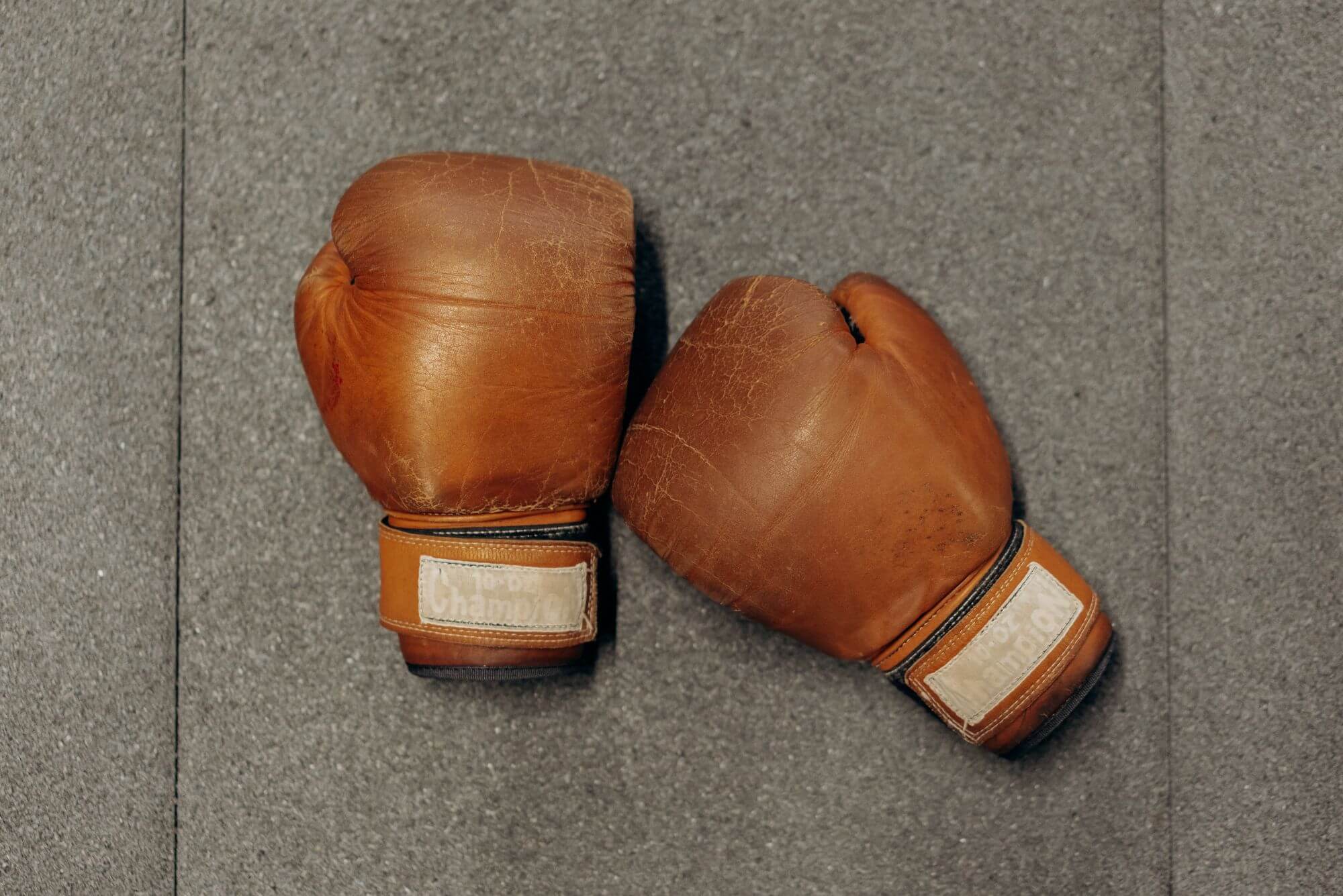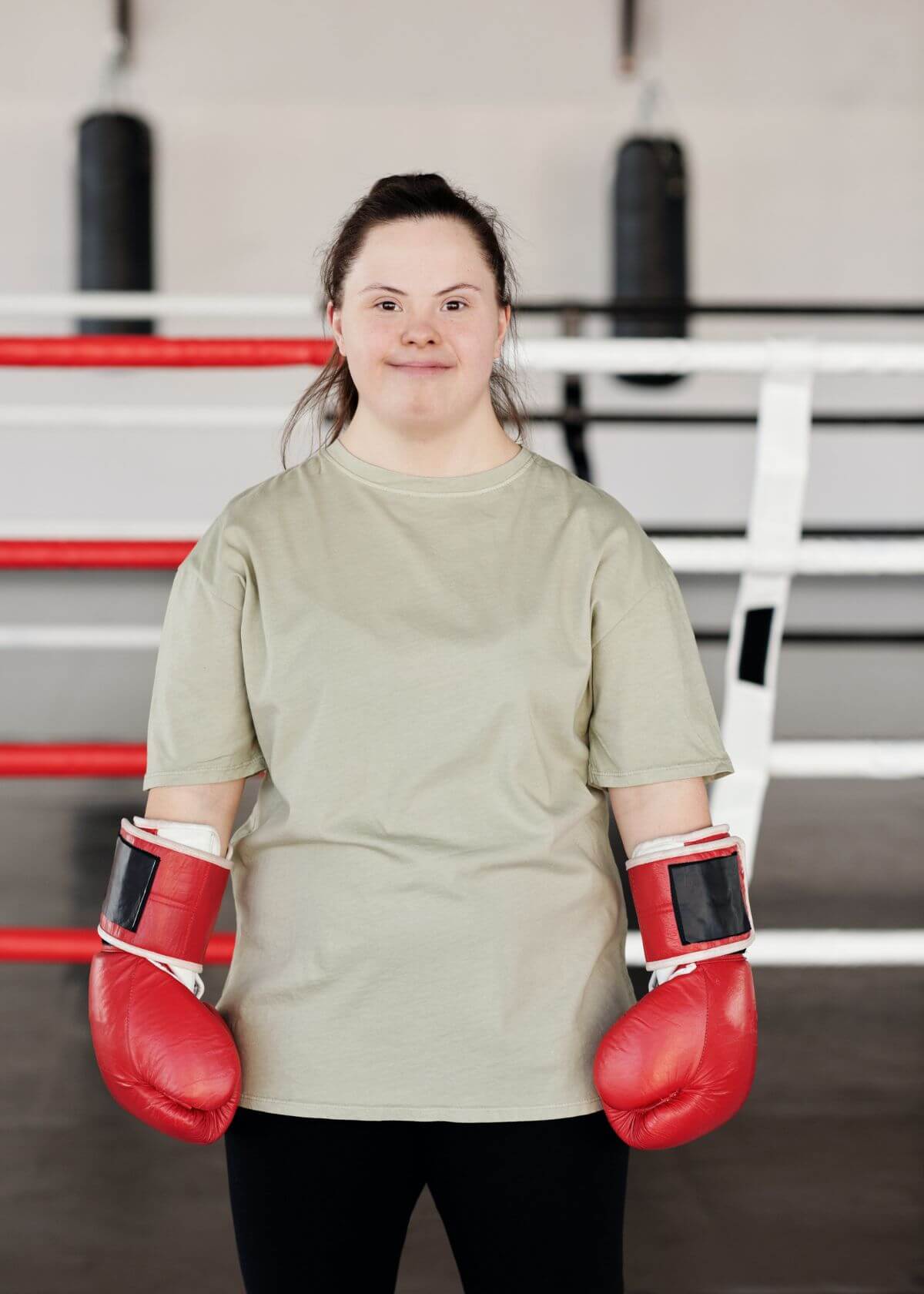Have you ever wondered how those beefy leather mitts you throw on before stepping into the ring are created? Before you lace up your gloves and get ready to spar, let us give you an inside look at how boxing gloves are made.
Over the past few decades, the boxing glove design has evolved to prioritize safety while preserving the sport's impact. Today, different sports like the UFC, Boxing, and Muay Thai have regulations regarding the padding and weight of gloves for other weight classes and competitive levels.
Some critical factors in how boxing gloves are made include material selection, use of precise boxing glove templates, padding application, and quality assurance testing. From the leather used to the stitching process and what boxing gloves are made of, we'll cover it all. So, let's get started:
How are Boxing Gloves Made - Complete 4 Step process
Step 1: Producing the Boxing Gloves
The first step in how boxing gloves are made involves careful template designing, selection of the right materials (leather and thread), and precision in cutting according to the template and stitching the cut parts. This step sets the foundation for the gloves' quality, durability, and overall performance in boxing and MMA.
Taking the template for the right glove size and design, and then lining the material
Selecting a suitable boxing glove template is critical for ensuring a proper fit, essential for safety and comfort during a fight or training session.
- Understanding different sizes: Boxing gloves typically vary from 8 oz to 20 oz. Choosing the appropriate template depends on the boxer's weight class, age, and purpose of the gloves—whether it's for competition, sparring, or bag work.
- Customizing boxing glove design: A well-designed glove will be functional and aesthetically pleasing. Designs may encompass everything from traditional solid colors to complex graphic prints that require precise application.
- Selecting a lining material: The inner lining of a glove is usually made from materials like polyester, taffeta, or other smooth fabrics to ensure comfort against the skin. This lining also helps absorb sweat, thus prolonging the life of the outer materials.
Cutting Outer Materials
Cutting the outer materials is done precisely to ensure all pieces fit together seamlessly during assembly.
- Choosing genuine leather or synthetic: Leather used in high-quality gloves is either cowhide or goatskin because of their durability and ability to mold to the wearer's hand over time. Some cost-effective gloves are made using synthetic leathers like PU (polyurethane), which offer a vegan alternative and are easier to clean.
- Understanding leather quality variations: The quality of leather affects not only the longevity but also the price of the gloves. Full-grain leather is top-tier due to its strength, whereas cheaper variants may use split leather or substitutes.
- The leather is sourced from the tannery in large chunks, then traced and cut as per the template for precise stitching later.
Stitching and Assembly of Additional Parts
Once all materials are cut and prepared, stitching and assembly commence, shaping the gloves into functional form.
- Stitching with nylon thread: Durable nylon thread is used for stitching pieces together due to its resistance to tearing and decomposition caused by sweat and friction.
- Glove shape formation: Initial stitching is often done inside out to assemble intricate parts easily and then flipped to hide seams, providing aesthetic appeal and better structural integrity.
- Inclusion of specific features:
- Breathable meshes may be integrated into areas where ventilation is needed.
- Grip bars can be sewn into the palm area to help maintain a proper fist.
- Knuckle guards are attached to the glove to create padding.
- Attaching separate parts:
- The thumb is assembled separately before being connected to maintain mobility.
- Velcro straps or laces are added around the wrist cuff for closure.
- Brand logos or patches are applied before shaping to ensure they lay flat and appear visually appealing.
- Graphic printing: Any designs or graphics are typically printed onto flat materials before they're shaped into parts of the glove, allowing for clarity in design and ease of application.
- Hand stitching for upscale gloves: Premium gloves may feature hand-stitched elements to enhance quality and add a bespoke touch. This process can also ensure each glove meets rigorous quality control standards.
| Material | Pros | Cons |
| Outer Materials | ||
| Genuine Leather (Cowhide) | - Durable and long-lasting | - Expensive compared to synthetic alternatives |
| Genuine Leather (Goatskin) | - Molds to the wearer's hand over time | - Limited availability, can be more expensive |
| Synthetic Leather (PU) | - Vegan alternative | - May not be as durable as genuine leather |
| - Easier to clean | - May not mold to the hand as well as genuine leather | |
| Inner Lining | ||
| Polyester | - Smooth against the skin, providing comfort | - May not absorb sweat as effectively as other materials |
| Taffeta | - Comfortable against the skin | - Durability may vary depending on quality |
| Other Smooth Fabrics | - Absorbs sweat, prolonging the life of outer materials | |
| Thread for Stitching | ||
| Nylon | - Durable, resistant to tearing and decomposition | - May require specialized equipment for stitching |
Step 2: Adding the Padding
As we go deeper into the question of how are boxing gloves made and specifically what boxing gloves are made of when it comes to their padding, we find that various materials come into play.
Traditionally, manufacturers used horsehair for padding, providing a firm, compact layer that contributes to the glove's stiffness and hitting power.
- Modern Padding Options: Today, though, most high-quality gloves use some form of foam padding.
- Layered Foams include materials like Polyurethane (PU), which provides a dense, impact-absorbing property to the padding. Many professional-grade gloves use multiple layers of foam with varying densities to balance protection, shock absorption, and durability.
- Injection Molded Foam (IMF): This refers to foam injected into a mold in liquid form and then allowed to expand and harden. This type of padding offers consistency in shape and density, ensuring an even distribution of impact energy.
- Latex or PVC Foam: Some manufacturers use latex foam or polyvinyl chloride (PVC) as an alternative, which can also vary in density but might not provide the same level of longevity as high-density polyurethanes or IMFs.
- Quality Considerations: The choice of padding can significantly affect the gloves' overall quality and functionality. Layered foams are particularly appreciated as they allow for custom configurations, selectively placing denser foam where maximum protection is required (e.g., over the knuckles) while using lighter, more flexible foam where mobility is paramount.
Design
- Effective Padding Placement: A proper boxing glove design considers how the padding will protect the hand upon impact. The density should be greatest on the impact zones, such as around the knuckles.
- Weight Variation: Boxing gloves come in different weights to cater to various classes and uses – from lighter gloves designed for speed work to heavier gloves intended for training. The amount and type of padding contribute significantly to the total weight of the glove.
- Regulatory Adherence: Manufacturers need to be aware of the rules set by sanctioning bodies in the sport of boxing and MMA. The design must meet these specifications, including requirements like whether the thumb is attached or not – a feature necessary for eye safety.
- Scoring Consideration: Particularly for amateur boxing competition equipment, a colored dye might be added to the knuckle area of the glove to help judges score hits accurately during a fight – this color contrast can highlight clean punches landed in scoring zones.
Stuffing the Glove
- Stitching in the Padding: After selecting the appropriate materials and finalizing the boxing glove template with due attention to boxing glove design principles, inserting padding is painstakingly done. It requires careful work where padding is fitted into each separately stitched section along with the glove's inner lining.
- Right-Side Out Assembly: Once the components have been stitched together inside-out for cleaner lines, the half-assembled glove needs to be turned right-side out. This can be a labor-intensive step, depending on the tightness and intricacies of the design.
- Layering Padding: Padding is layered in specific sequences between the outer leather and inner lining, especially around the knuckle area. This methodical stacking is what gives a glove its protective characteristics.
- Padding is cut according to the boxing glove template and often hand-stuffed for precision.
- Special attention is paid during this stage to ensure all materials are aligned and intact, which could compromise safety and comfort.
- The fitting and securing of this protective layer have to ensure long-lasting durability; thus, additional stitching methods, such as backstitching or reinforcement stitches, are commonly employed at stress points.
| Material | Pros | Cons |
| Horsehair | - Provides a firm and compact layer contributing to glove stiffness and hitting power. | - Limited shock absorption compared to modern foam materials. |
| Polyurethane (PU) Foam | - Dense and impact-absorbing padding. | - It may offer less flexibility than other foam types. |
| Injection Molded Foam (IMF) | - Offers consistency in shape and density. | - The production process can be more complex and expensive. |
| Latex Foam | - Cheaper and heavier | - May not provide the same level of longevity as high-density polyurethanes or IMFs. |
| PVC (Polyvinyl Chloride) Foam | - Good shock absorbers | - May not provide the same level of longevity as high-density polyurethanes or IMFs. |
Step 3: Wrapping Up
When understanding how are boxing gloves made, particularly completing the gloves, manufacturers must decide on the type of closure system to be used and add the finishing touches after applying padding and attaching the thumb.
There are generally two types of closure systems used in boxing gloves: laces and Velcro (hook-and-loop). Each has its distinct advantages and applications within the sport of boxing.
- Laces or Velcro added based on design: Professional quality gloves typically use laces for a snug, customizable fit, which is paramount in competitive fight scenarios. Alternatively, gloves designed for training may use Velcro closures for ease of use and the ability to be put on or removed without assistance.
- Template for laces or stitching Velcro strap into place: The boxing glove template comes into play when laying out where to position the holes for laces or stitching the Velcro strap in place. Precision is critical to ensure that the closure mechanism holds securely and maintains the integrity of the glove design.
- A thin strip of leather folded over cuff and palm edges, stitched to finish: Aesthetics and durability are vital in the manufacturing process. Therefore, a thin strip of leather or a durable synthetic material is folded over the rough edges at the cuff and palm area and closely stitched to create a tidy, finished look that helps prevent wear and tear.
- Labels added, gloves packaged for shipping: Every completed pair of gloves receives branding labels, which may include logos, size indicators, care instructions, and any additional required consumer information. Once labeled, they are carefully packaged to avoid any damage during transport. This could be into individual bags or boxes depending on what materials the manufacturer decides are best suited for preserving the glove quality during shipping.
| Material Used | Pros | Cons |
| Closure Systems: | ||
| Laces | - Provides a snug, customizable fit - Preferred for professional quality gloves - Suitable for competitive fight scenarios |
- Time-consuming to put on and remove - Requires assistance for fastening |
| Velcro (Hook-and-Loop) | - Quick and easy to put on and remove - Ideal for training gloves |
- May wear out over time with repeated use - May not offer as precise fit as laces |
| Closure Mechanism Materials: | ||
| Leather or Synthetic Material | - Adds durability to the closure system - Provides a finished and tidy appearance |
- Quality can vary based on the material used |
| Cuff and Palm Edges: | ||
| Thin Strip of Leather or Synthetic Material | - Enhances aesthetics and durability - Prevents wear and tear at cuff and palm edges - Creates a tidy, finished look |
- Quality depends on the material used |
Step 4. Quality Control:
Once the boxing gloves have been assembled, they move on to the all-essential quality control phase. Quality is crucial in boxing gear since it ensures the athletes' safety and the sport's integrity. Here is how this process typically works:
- Inspection for Defects:
- Each glove is visually inspected for imperfections in the leather or other materials.
- Stitching quality is examined meticulously to ensure no loose threads or uneven seams could affect durability.
- Testing by Authorized Bodies:
- Many countries have governing boards for boxing, such as the British Boxing Board of Control, which have set stringent guidelines and testing procedures.
- Governing bodies might require manufacturers to submit samples for testing. They could maintain a list of approved boxing gloves that meet their standards for professional fights.
- Impact Testing:
- Gloves are often tested on a maple block designed to mimic the density and shape of a human fist, which helps simulate real fight conditions.
- These gloves might then be fired at a test dummy equipped with sensors to measure the impact force delivered.
- Measuring Impact Severity:
- The readings from these tests are then measured and evaluated using a severity index. This ensures that the gloves provide adequate protection to both the wearer and the opponent.
- Gloves must distribute impact effectively to minimize the risk of concussions or bone fractures during a fight.
- Regular Auditing:
- Companies may also be subject to regular audits by independent quality assurance organizations that ensure consistent quality production over time.
Throughout these steps, different materials are used with varying qualities that ultimately determine what boxing gloves are made of. Leather remains the most popular choice for its durability and comfort but requires skilled stitching to ensure longevity.
Many manufacturers also use synthetic leather, which is cheaper and has different maintenance needs than natural leather. Modern boxing gloves incorporate various materials for padding, like latex foam, EVA foam, and even gel, tailored to other aspects of boxing training or competition.
High-quality craftsmanship sees many brands hand-stitch their gloves and guards, which often results in superior durability compared to machine stitching. Meanwhile, reinforced double stitching or even triple stitching may be employed in areas where more flexibility is essential or high stress is expected - such as at creases or between fingers.
Aspects such as weight distribution, ergonomic fit (often tested against a standardized boxing glove design template), and ventilation are also considered in the finishing stages. The completion phase ensures that each aspect of the boxing glove design works in concert to provide optimal performance during training or a fight, maintaining the standards expected from professional gear in both boxing and MMA disciplines.

Frequently Asked Questions:
What were the first boxing gloves made of?
The evidence of the oldest boxing gloves made goes back to ancient Egyptians in 2000 BC and Minoans in 1500 BC. Those gloves were made primarily from leather strips that fighters used to wrap around the wrists and knuckles. These early gloves were designed more for protecting the fighter's hands than their opponent's head, unlike today's more safety-conscious designs.
What is a boxing glove sewing pattern, and why is it important?
A boxing glove sewing pattern, commonly called a boxing glove template, is a blueprint used in manufacturing to cut out the correct shapes from materials before stitching them together. This pattern ensures glove size and shape consistency, which is crucial for the gloves' quality and performance. It helps maintain uniformity across different sizes of boxing gloves, ensuring a proper fit for boxers.
Can you make boxing gloves yourself?
Yes, it is possible to make boxing gloves yourself with a thorough understanding of how they are made and have access to suitable materials, tools, and a precise boxing glove template.
Crafting your own gloves involves cutting materials according to the boxing glove design, then sewing and stuffing them appropriately. However, creating high-quality and safe gloves comparable to professional gear used in boxing or MMA requires advanced skills in sewing and design.
What are boxing gloves made of?
Boxing gloves are typically manufactured using leather or synthetic materials like vinyl for the exterior and are padded with various types of foam for shock absorption. The choice of material often affects the gloves' quality, durability, and comfort. High-quality leather gloves are more durable, while synthetic materials can offer a vegan alternative and are sometimes more affordable.
Looking For Boxing Gloves That Pack a Powerful Punch?
When selecting boxing gloves, it's essential to choose a pair made from durable materials like leather or synthetic vinyl that can withstand repetitive impacts over multiple training sessions.
Quality glove construction also matters - the foam padding should be high-density EVA to properly cushion blows without breaking down. Reinforced seams and anatomical fits further enhance protection and comfort.
MMA fighters likewise rely on well-made handguards to facilitate varied techniques while still protecting their hands.
For boxing or MMA, considering reviews and manufacturer reputations for using sturdy materials, strong stitching, and designs optimized for performance can lead you to a great pair of gloves.
Check out our best boxing gloves review for an in-depth analysis of the top options available. With the right gloves, any fighter can unleash powerful punches with full confidence in their protective equipment.



